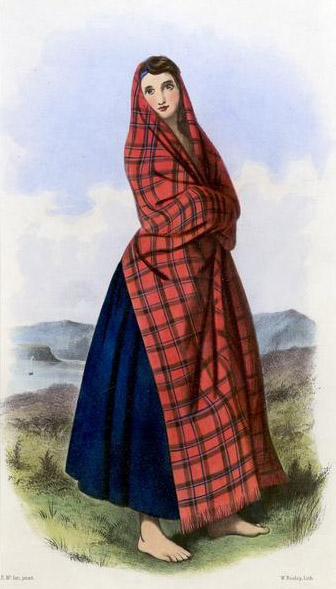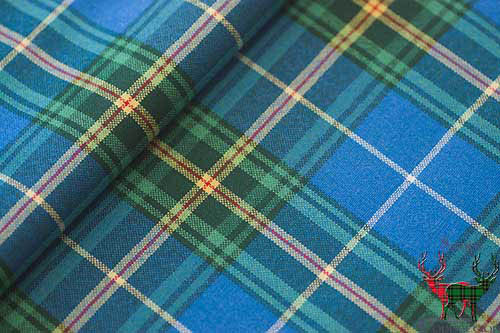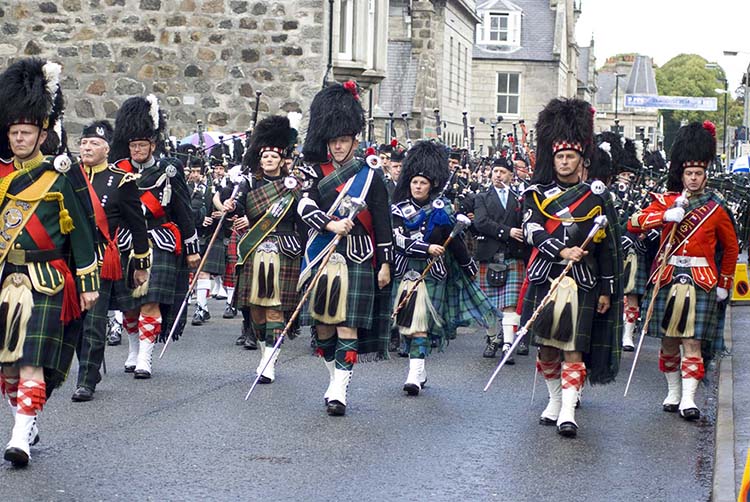 |
Sinclair Clanswoman, Robert Ronald McIan, 1845 |
Over the 19th century, the wearing of Highland dress on both formal and informal occasions, accelerated. With the British Royal Family annually in residence in Aberdeenshire, Scottish Highland dress acquired an unexpected sophistication. Consider, for example, R.R. McIan's fanciful series of the costumes of the clans drawn for the Highland Society in 1845. Tartan can make any plumage look dowdy while Scottish Highland dress is uniformly dignified and impressive and adapts to every occasion.
And by the early 20th century, great Scottish entertainers such as Sir Harry Lauder had carried the traditions overseas, connecting with the thousands of expatriate Scots who were, by then, established in the New World. The wearing of the kilt and its accessories, albeit occasionally caricatured and made comical, rapidly became an international symbol of Scotland's pride. Nowhere is this more impressive than in the Kirkin o' the Tartan traditions of North America.
 |
Nova Scotia Tartan |
In the third millennium, Scottish clans and families worldwide have a wide and colourful choice of patterns and colours to choose from, but not everyone needs to belong to a clan to be eligible to wear a tartan. Australia has its very own plaid, as does Canada, Cape Breton, Nova Scotia, Newfoundland, Quebec, Ohio, Texas, Washington and New York. Even Scotch whisky companies, fashion designers, membership organisations, airlines, and countless manufacturing and commercial interests have registered exclusive thread counts.
 |
Pipe Bands, Gordon Street, Huntly, Aberdeenshire |
In 1991, responding to action which had already been initiated by the Clans & Scottish Societies of Canada, the Ontario Legislature passed a resolution to create the 6th April, the anniversary of the signing of the Declaration of Arbroath in 1320, National Tartan Day. America followed this example in 1998, when Senate Resolution 155 for a National Tartan Day, proposed by the US Senate Majority Leader Trent Lott, was passed unanimously.
Tartan Day is therefore celebrated annually across Canada and the United States of America. However, in New Zealand and Australia, Tartan Day falls on 1st July, commemorating the date of the repeal of the Act of Prescription in 1782.
In 2008, the Scottish Register of Tartan Act received Royal Assent, and, in February 2009, the Scottish Register of Tartans was launched by the National Archives of Scotland (NAS). The Register is maintained by the NAS to provide an official focal point for tartan design and production, as well as for genealogical research. Data from the two private registers already in existence, the Scottish Tartan Authority and the Scottish Tartans World Register, has been amalgamated in the new Register. The Keeper of the Records of Scotland is now also the Keeper of the Scottish Register of Tartans, and the Court of the Lord Lyon King of Arms retains a supporting role.
The Scottish Register of Tartans Act 2008 specifies the criteria which new tartans are required to meet and the official vetting processes have been introduced to promote and protect the status of registered tartans.
©2025 Scots Connection
























